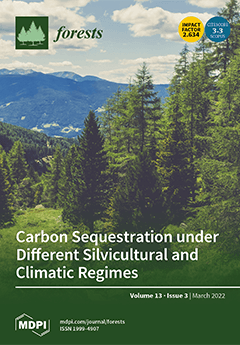Climate change has a significant impact on species population size and distribution, global biodiversity, and ecological status. The
Liriodendron genus contains two species:
Liriodendron chinense and
Liriodendron tulipifera, both playing important roles in timber, medicinal, and landscape purposes. However, little is known
[...] Read more.
Climate change has a significant impact on species population size and distribution, global biodiversity, and ecological status. The
Liriodendron genus contains two species:
Liriodendron chinense and
Liriodendron tulipifera, both playing important roles in timber, medicinal, and landscape purposes. However, little is known about their population distribution characteristics and important climatic factors shaping their suitability. In this research, we used the geological record data, 19 climate components, MaxEnt, and ArcGIS to recreate and analyze the potential population distribution and their alterations of
Liriodendron within the world beneath the current and future scenarios of RCP 2.6, RCP 4.5, and RCP 8.5 in 2050 and 2070. Our results showed that:
Liriodendron is suitable to grow in subtropical monsoon climate areas, and that the climatic factor of precipitation of warmest quarter exerts the greatest impact on
L. chinense, with a contribution rate of 57.6%. Additionally, we showed that the climatic factor of precipitation of the driest month exerts the greatest impact on
L. tulipifera, with a contribution rate of 60.5%. Further analysis exhibited that low temperature and temperature fluctuations are major temperature factors affecting
L. chinense and
L. tulipifera, respectively. Therefore, we predicted that by the 2050s and 2070s, the areas of
Liriodendron suitable habitats would increase first and then decrease in three scenarios; except the area of
L. tulipifera suitable habitats under RCP8.5, which shows a slight increase. We then conclude that the
Liriodendron suitable areas would shift to high latitudes due to global climate warming. The information gained from this study will provide a reference for developing forest cultivation, management, and conservation strategies for these two important tree species, and also a basis for subsequent biogeographic research.
Full article





